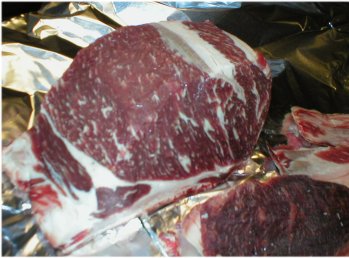
Good Cooking since 1995

Dry Aging Beef
Dry aging occurs while the beef is hanging in a refrigerated cooler, at a specific temperature and humidity, for 10 to 28 days after harvest and prior to cutting. When beef is dry aged two things happen. First, moisture evaporates from the muscle creating a greater concentration of beefy flavor and taste. Secondly, the beef s natural enzymes break down the fibrous, connective tissue in the muscle, tenderizing it. Most of the tenderizing activity occurs in the the first 10 to 14 days. Some high quality restaurants age their meat for 28 days or more. Increased aging adds to the shrinkage and trim loss due to the drying and surface mold. Up until 20 years ago, dry aged beef was the norm, then with the advent of vacuum packaging along with increased efficiencies in beef processing and transportation, we lost the dry aging process. In today s modern processing plants, the carcass is broken down and vacuum-sealed in plastic bags within 24 hours. Much of this beef will show up in a grocery store meat case within 2 to 4 days after harvest. Beef can be "wet aged" in a vacuum-sealed plastic bag for improved tenderness but it will not have the characteristic dry aged flavor. Because refrigerated storage is expensive, only the high priced loin and rib cuts are aged (wet or dry). It's been decades since butchers first discovered that beef carcasses, left hanging for several days, ended up more tender and palatable as natural enzymes in the meat broke down proteins and connective tissue. Today the "wet" process is primarily used for aging steaks. Wet aging is done by allowing the beef to age in a vacuum packed bag. Dry aging was big in the 50's and 60's, then the market moved to the less-costly boxed beef and vacuum packaging. 99% of Supermarkets today sell boxed beef. In the 100's, dry aging enjoyed a resurgence. Dry-aged steak is aged in the open air at controlled temperature between 34 F and 38 F with an ambient humidity level adjusted between 50% and 75%. Wet-aged meat is placed in a vacuum-sealed bag. Dry-aged beef requires 7 to 14 days or longer to age properly. Wet-aged beef can mature in as few as 7 days. Meat is muscle, and muscle is composed of protein structures that break down with the aging process. This results in more tender cuts of meat and more flavor. It's the benign bacteria within the meat itself that causes the degradation. Air circulation is essential in managing dry aging and is perhaps the biggest reason why dry-aged beef costs substantially more, since the resultant evaporation causes significant shrinkage. Typical shrinkage is 10 to 15%. And dry-aged beef usually cost about 25% more than wet aged beef. (Credit to Arizona Barbecue Association (ABA))

Aging Beef at Home!
1. Only the top grades of beef can be dry aged successfully. Use USDA Prime or USDA Choice - Yield Grade 1 or 2 (the highest quality of Choice) only. These have a thick layer of fat on the outside to protect the meat from spoiling during the aging process.
2. Buy a whole rib-eye or loin strip. [You cannot age individual steaks.] Unwrap it, rinse it well with cold water, and allow it to drain; then pat it very dry with paper towels.
3. Wrap the meat in immaculately clean, large, plain white cotton dish towels and place it on the bottom shelf of the refrigerator - which is the coldest spot.
4. Change the towels each day, replacing the moisture-soiled towels with fresh. Continue to change towels as needed for 10 days, to 2 weeks. (See Step #7 for cleaning towels.)
5. After the desired aging time, you're ready to cut off steaks from each end, trim as desired, and allow the rest to continue to age in the refrigerator.
6. If, after 21 days, you have not eaten all the meat, cut the remaining piece into steaks, wrap each steak in freezer-proof, heavy-duty plastic wrap, and freeze. The steaks will keep for several months in the freezer.
7. To clean the towels for re-use, soak the soiled towels, immediately upon removing them from the meat, in cold water overnight. Next, soak them in cold, salted water for 2-3 hours to remove any blood stains. Then launder as usual. In olden days, butchers used to cover sides of beef with cotton "shrouds" during the aging process - this is essentially the same thing.